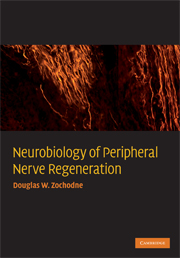Book contents
- Frontmatter
- Contents
- Acknowledgments
- 1 Introduction
- 2 The intact peripheral nerve tree
- 3 Injuries to peripheral nerves
- 4 Addressing nerve regeneration
- 5 Early regenerative events
- 6 Consolidation and maturation of regeneration
- 7 Regeneration and the vasa nervorum
- 8 Delayed reinnervation
- 9 Trophic factors and peripheral nerves
- 10 The nerve microenvironment
- References
- Index
- Plate section
- References
3 - Injuries to peripheral nerves
- Frontmatter
- Contents
- Acknowledgments
- 1 Introduction
- 2 The intact peripheral nerve tree
- 3 Injuries to peripheral nerves
- 4 Addressing nerve regeneration
- 5 Early regenerative events
- 6 Consolidation and maturation of regeneration
- 7 Regeneration and the vasa nervorum
- 8 Delayed reinnervation
- 9 Trophic factors and peripheral nerves
- 10 The nerve microenvironment
- References
- Index
- Plate section
- References
Summary
Peripheral nerve injuries are common, disabling and difficult to treat. These injuries arise because nerve trunk anatomical pathways expose them to a variety of injury types, including both blunt and penetrating lesions. The injury type, in turn, has a major bearing on how nerves respond. There are unique and challenging attributes of nerve trauma biology that set the stage for subsequent regenerative activity. These attributes are examined in this chapter.
Overall considerations
The type of injury experienced by a peripheral nerve determines how regeneration might proceed. Several classifications exist and are given here. The simplest classification is provided by Seddon, who grouped injuries into neurapraxia, axonotmesis, and neurotmesis lesions.
Neurapraxia is a lesion that occurs most often from blunt nerve trauma and involves focal demyelination over several internodes at the injury site. By definition, there is no associated axonal injury. Since neurapraxic lesions are identified by the loss of function associated with them, they require that enough internodes be disrupted to block conduction, or function. For example, a common type of neurapraxic lesion is the “Saturday night palsy” of the radial nerve in the arm that develops from prolonged compression of the inner arm by a chair or the head of a partner (and is often associated with alcohol intoxication!). Compression, however, need not be prolonged, since it is highly likely that the mechanical distortion of the nerve is responsible for demyelination. Ochoa and colleagues, in experimental work, described how myelinated axons “intussuscept” from undue mechanical stress [521].
- Type
- Chapter
- Information
- Neurobiology of Peripheral Nerve Regeneration , pp. 39 - 57Publisher: Cambridge University PressPrint publication year: 2008



